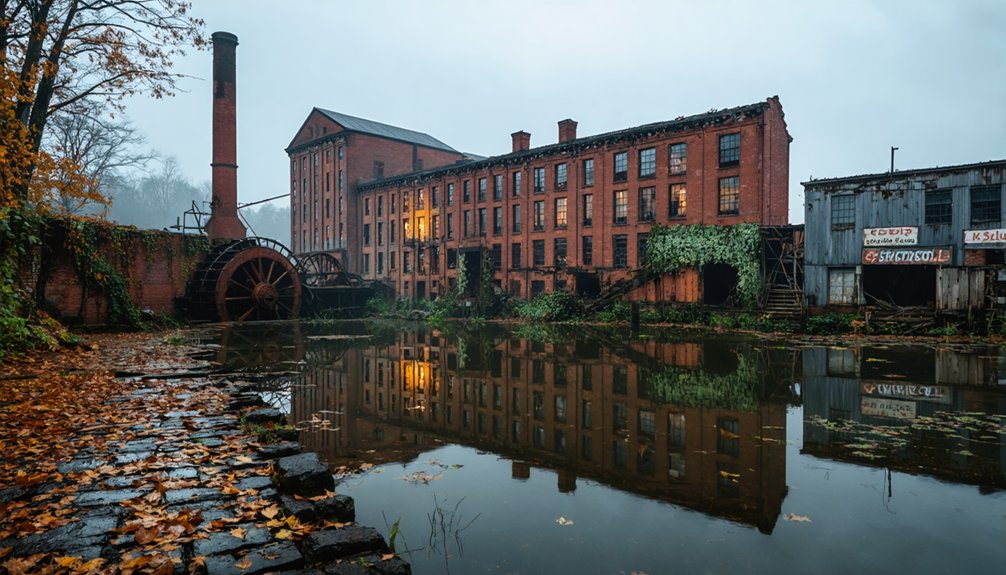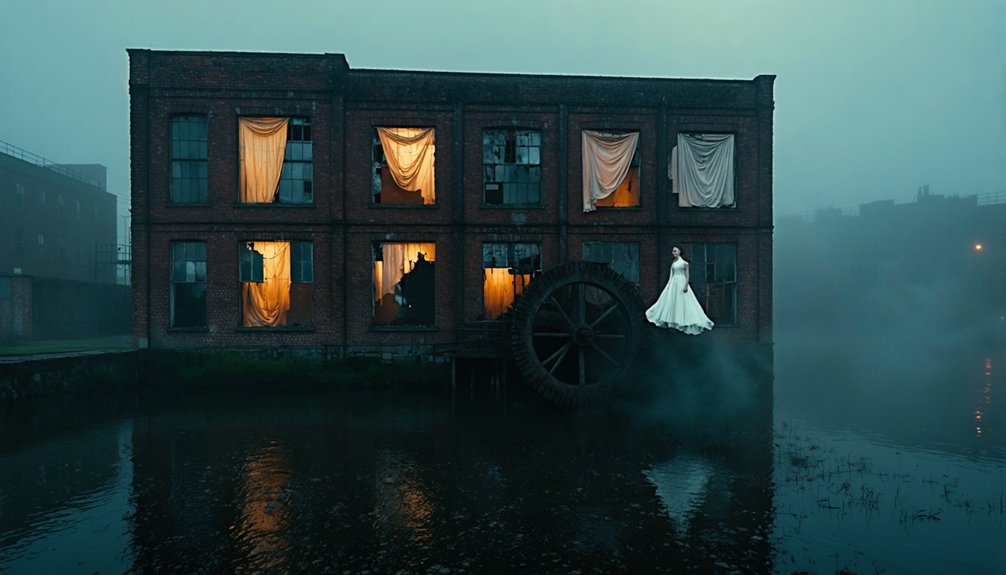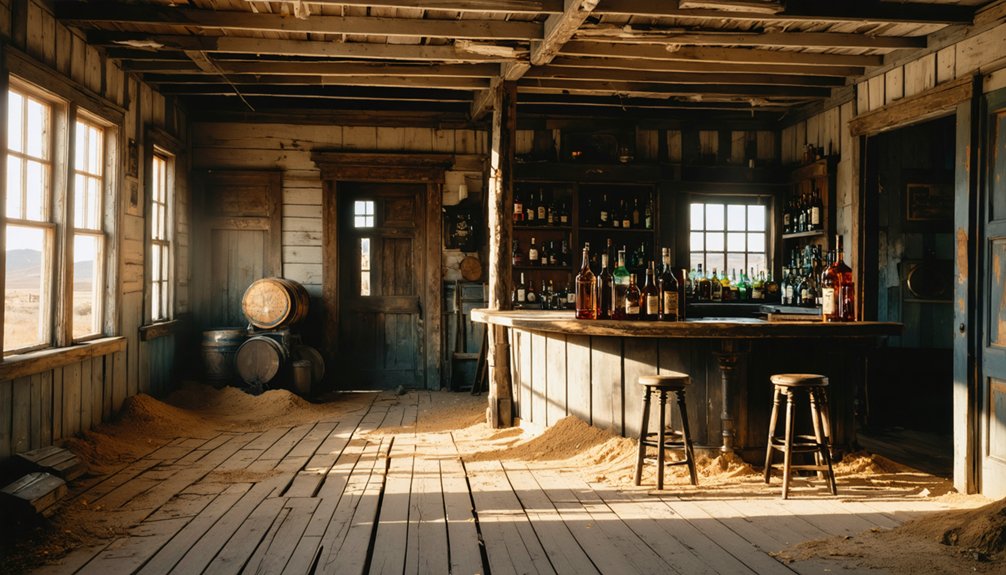You’ll discover America’s most haunted mill towns in places like Bodie, California, where 65 saloons once fueled violent mayhem, and Centralia, Pennsylvania, where underground fires have burned since 1962. From Dudleytown’s colonial curses to Kennecott’s crimson mill rising against Alaskan glaciers, these abandoned industrial sites tell tales of prosperity and darkness. Watch for spectral miners in Frisco, Utah, where two murders per night once terrorized the silver-boom streets. Each crumbling building holds deeper secrets within its walls.
Key Takeaways
- Kennecott, Alaska features a haunting 14-story red mill building where ghostly machinery and unexplained phenomena are frequently reported.
- Crystal Mill in Colorado stands as an eerie reminder of 1880s mining operations, with mysterious occurrences reported near its abandoned structure.
- The massive Kennicott Mill in Alaska creates an otherworldly atmosphere with its crimson facade against glacier views and paranormal activity.
- Fayette, Michigan’s iron smelting town harbors ghost sightings in its well-preserved industrial ruins, particularly around Laborer’s Alley.
- Bodie, California’s preserved mill structures contribute to its reputation for paranormal activity and the infamous “Bodie Curse.”
Bodie, California: The Wild West’s Most Notorious Ghost Town
While many ghost towns dot the American West, few can rival the notoriety and preservation of Bodie, California. Founded in 1859 after a gold discovery, this once-booming town swelled to 10,000 residents by the 1880s and produced over $38 million in gold and silver.
Bodie stands as the Wild West’s best-preserved ghost town, where $38 million in precious metals once flowed through its prosperous streets.
You’ll find a town frozen in time, with 170 original buildings maintained in “arrested decay” exactly as they were left in the 1940s.
Bodie legends tell of a lawless paradise where 65 saloons operated amid frequent violence and vice. The town developed a hydro-electrical center in 1893, showing remarkable innovation for its era. The Standard Mining Company’s rich gold vein discovery in 1877 transformed Bodie from a small camp into a bustling city.
Today, you can explore the haunting remains of this official state gold rush ghost town, where ghost sightings are frequently reported near the old saloons, mining buildings, and notorious Boothill Graveyard.
The town’s violent past has spawned countless paranormal tales, including the infamous “Bodie Curse” that’s said to follow those who disturb its ruins.
Centralia, Pennsylvania: The Town That Burns From Below
As you walk through Centralia’s abandoned streets today, you’ll witness an otherworldly scene where smoke rises eternally from cracks in the ground, fed by an underground mine fire that’s burned since 1962.
Local folklore tells of shadowy figures glimpsed through the toxic haze, while some residents claim to hear mysterious sounds echoing from the labyrinth of burning tunnels below.
The town’s population has dwindled from 1,300 to just five hardy souls who’ve refused to leave, even as their neighbors’ homes were demolished and nature slowly reclaims what remains of this once-thriving mining community. The remaining residents won a 2013 legal settlement that allows them to stay in their homes for life, though their properties will revert to state ownership upon their departure. Scientists estimate the fire beneath the town will continue to burn for 600 to 1000 years, making it one of America’s longest-lasting environmental disasters.
Underground Fire’s Eternal Grip
Since May 1962, an eternal blaze has gripped the depths beneath Centralia, Pennsylvania, transforming this once-thriving coal town into America’s most infamous underground inferno.
What started as a routine trash fire in an abandoned strip mine ignited a nightmare that’s consumed nearly 4,000 acres of coal seams. You’ll find this underground fire burning up to 300 feet below the surface, advancing relentlessly at 75 feet per year through a maze of abandoned mines. The toxic combination of heat and oxygen continues to fuel the flames through the extensive tunnel network.
The environmental impact has been catastrophic. Toxic fumes seep through fissures, while the ground itself has become treacherously unstable. The area’s population plummeted from 1,500 residents in the 1980s to just five people by 2017.
You’re looking at a landscape riddled with 80-foot sinkholes and crumbling infrastructure. Despite decades of attempted interventions, the fire continues its unstoppable march, projected to burn for another 250 years.
Ghost Stories Above Ground
The underground inferno of Centralia has birthed a haunting landscape above ground that’s equally mesmerizing and dangerous.
You’ll encounter thick smoke rising from cracked streets and eerie fog enveloping the old cemetery, while toxic gases seep through fractures in the unstable earth beneath your feet.
Local legends speak of ghostly apparitions near the steam vents, tied to Father McDermott’s alleged curse on the town.
Urban myths about government cover-ups have flourished alongside stories of lost souls trapped by the eternal fire below.
The town’s unsettling atmosphere even inspired the horror game Silent Hill, cementing Centralia’s place in modern folklore.
Ground temperatures reaching 626 degrees Fahrenheit create an apocalyptic hellscape that feeds visitors’ imaginations.
Despite official warnings, urban explorers and paranormal investigators continue to document the abandoned buildings, graffiti-covered roads, and otherworldly haze that define this real-life ghost town.
The Pennsylvania Department of Environmental Protection maintains its Stay Out, Stay Alive campaign to warn visitors of the area’s deadly hazards.
Toxic Fumes Create Shadows
Beneath the scarred landscape of Centralia, Pennsylvania, an underground inferno has raged unchecked since 1962, when borough workers inadvertently ignited a coal seam while burning trash in an abandoned strip pit.
As you walk these abandoned streets today, toxic shadows dance around your feet – billowing sulfurous fumes that rise from fissures in the earth like underground whispers.
You’ll smell the rotten egg scent before you see the steam vents that pipe these deadly gases away from what remains of the town. Scientists estimate this underground blaze will continue to burn for another 250 years.
The inferno has transformed this once-thriving community into a wasteland, killing vegetation and creating a barren moonscape.
In basements and crawl spaces, deadly gases accumulate, forcing residents to install special venting systems or abandon their homes entirely.
Dudleytown, Connecticut: Dark Legends of the Colonial Curse
Located in Cornwall, Connecticut, Dudleytown emerged as a colonial settlement in the early 1740s, bearing a sinister reputation that would haunt its legacy for centuries.
You’ll find its origins tied to Gideon Dudley, who purchased land from Thomas Griffis in 1747, establishing what would become one of America’s most notorious ghost towns.
The settlement’s dark history traces back to England, where Edmund Dudley’s beheading by King Henry VIII allegedly sparked a family curse.
As Dudley’s descendants settled in Connecticut, you’d witness a series of tragic events unfold – from Gershom Hollister’s 1792 murder to mysterious deaths, tuberculosis outbreaks, and reports of madness.
Today, while the Dark Entry Forest Association protects the abandoned site, Dudleytown’s reputation as a cursed colonial settlement continues to captivate those drawn to America’s haunted heritage. Visitors often report an unnatural silence in the woods, marked by the peculiar absence of wildlife and songbirds.
Fayette, Michigan: Echoes of the Iron Smelting Past
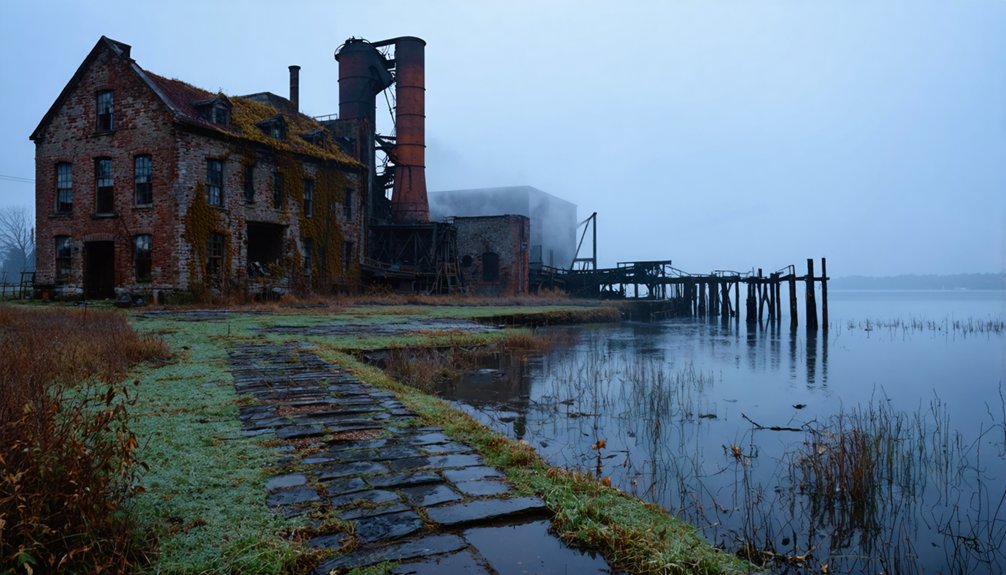
Standing proudly along Michigan’s Garden Peninsula, Fayette emerged in 1867 as a bustling iron smelting town that would transform the region’s industrial landscape.
During its heyday, you’ll find this company town produced over 229,000 tons of high-quality pig iron, drawing nearly 500 residents to its limestone-cliff shores.
Today, as you explore the Fayette Historic Townsite, you’ll discover remarkably preserved remnants of its industrial past.
Walk through the old blast furnace complex, company store, and worker neighborhoods that tell the story of 19th-century life.
The town’s ghostly apparitions are said to echo through Laborer’s Alley and the superintendent’s mansion, while the reconstructed charcoal kilns stand as silent witnesses to Fayette’s history – a legacy that came to an end in 1891 when the fires finally went cold.
Frisco, Utah: Silver, Shootouts, and Spectral Sightings
You’ll find yourself stepping into one of the West’s most notorious silver mining towns, where Frisco’s reputation for averaging two murders per night earned it the moniker of “Dodge City, Tombstone, Sodom, and Gomorrah all rolled into one.”
When Sheriff William Pearson arrived to restore order, he famously killed six men on his first night and established a no-jail policy of death or exile for lawbreakers.
Today, the abandoned beehive-shaped charcoal kilns and cemetery stand as silent witnesses to this violent past, where visitors report unexplained phenomena near the collapsed Horn Silver Mine that once yielded $60 million in precious metals.
Wild West Violence History
While many Western boomtowns earned reputations for lawlessness, Frisco, Utah, stood apart as one of the most violent settlements in American frontier history. You’d find a staggering 23 saloons in this wild west outpost, where murder became so commonplace that a wagon made daily rounds to collect the dead.
Known as “the wildest town in the Great Basin,” Frisco’s violent history earned it comparisons to Dodge City and Tombstone combined.
It wasn’t until Sheriff Pearson arrived from Pioche that order emerged from chaos. With his iron-fisted approach, he’d gun down known murderers on sight, briefly taming the lawlessness before the great mine collapse of 1885.
Today, Frisco’s abandoned ruins stand as silent witnesses to its brutal past, where ghostly legends still echo through the desert air.
Abandoned Mine Paranormal Activity
Deep beneath Frisco’s weathered surface, the Horn Silver Mine harbors more than just abandoned tunnels and sealed shafts. The catastrophic 1885 cave-in that rocked the earth miles away seems to have awakened something in these haunted tunnels.
You’ll hear stories of spectral miners whose footsteps echo through damp passages, and mysterious cart sounds that emerge from sealed depths where no living soul ventures.
Around the historic beehive kilns and industrial ruins, you’ll encounter inexplicable cold spots and shadowy figures that defy explanation.
The mine’s remaining infrastructure – creaking timber supports, rusted tracks, and ancient ventilation systems – amplifies the unsettling atmosphere.
Even today, smoke occasionally seeps from sealed entrances, hinting at the restless energy that lingers in this once-prosperous silver mine’s depths.
Last Residents’ Eerie Tales
In the waning days of Frisco’s mining era, the last 15 residents witnessed their once-bustling town transform into a haunting shell of its former glory.
As buildings emptied and streets grew quiet, these final inhabitants reported increasingly strange phenomena echoing through the abandoned structures. They’d encounter inexplicable cold spots in vacant homes and hear phantom footsteps in empty saloons.
The last residents’ ghostly encounters often centered around shadowy figures lurking near old mine entrances and eerie sounds drifting from the town’s 23 former saloon sites.
They reported disembodied voices and unexplained temperature drops in buildings where violent deaths had occurred years before.
These firsthand accounts of paranormal activity would later become foundational to Frisco’s reputation as one of America’s most haunted mining towns.
St. Elmo, Colorado: Where Annabelle Still Keeps Watch
Among Colorado’s best-preserved ghost towns stands St. Elmo, where the protective spirit of Annabelle Stark still watches over the historic buildings.
You’ll find this 1880s mining settlement nestled in the Sawatch Range, its well-maintained structures telling tales of gold, silver, and ghostly sightings that draw visitors year after year.
The Stark family’s dedication to historical preservation kept St. Elmo intact long after the mines closed and the railroad departed in 1926.
Today, you can explore the General Store and Home Comfort Hotel, both former Stark family businesses, where witnesses report paranormal activity, especially near the upstairs windows.
The town’s rich heritage earned it a spot on the National Register of Historic Places in 1979, and its Main Street remains largely unchanged, offering you a genuine glimpse into Colorado’s mining era.
Kennecott, Alaska: Copper Dreams and Mountain Spirits
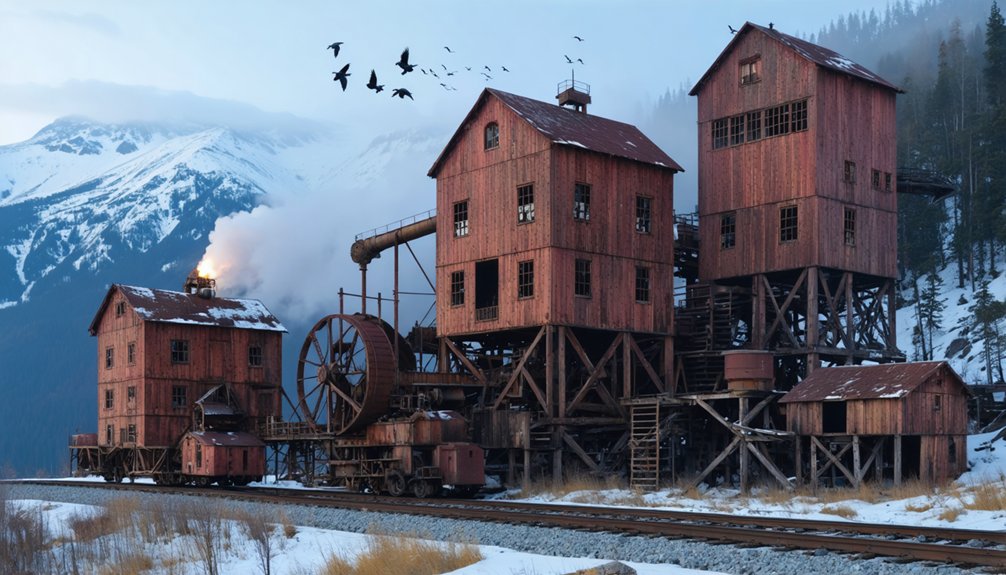
You’ll find the remnants of a once-mighty copper empire in Kennecott, where the iconic 14-story red mill building still stands sentinel against Alaska’s remote mountain peaks.
The abandoned mining equipment, frozen in time since 1938, creates an eerie atmosphere as it rusts quietly among the preserved buildings of this National Historic Landmark.
From the mill’s upper floors, you can gaze out at the dramatic views of the Kennicott Glacier and surrounding Wrangell Mountains, where some say the spirits of former miners still wander the peaks they once worked.
Remote Mining Empire’s Fall
Deep within Alaska’s rugged wilderness, the Kennecott copper mines once stood as a symbol of American industrial might and innovation.
You’ll find the haunting Kennecott Ruins nestled among mountains, where a copper legacy worth over $4 billion in today’s money was extracted from the earth. By the mid-1920s, this remote mining empire’s fate was sealed as rich ore bodies depleted and copper prices plummeted during the Great Depression.
- The iconic fourteen-story red concentration mill stands silent, its innovative ammonia leaching systems now frozen in time.
- Empty mine shafts of Bonanza, Jumbo, and Mother Lode tell tales of over 1.3 billion pounds of copper extracted.
- Abandoned buildings and ghostly railway tracks remind you of the sudden exodus on November 11, 1938, when the last residents departed.
Today, these preserved structures serve as a powerful reflection of American frontier spirit and industrial ambition.
Ghostly Mining Equipment Remains
The imposing 14-story mill building looms over Kennecott’s frozen landscape, its red frame a stark reminder of Alaska’s copper mining heyday.
Inside, you’ll find ghostly machinery scattered across multiple levels – silent witnesses to the ambitious copper extraction operation that once thrived here. Massive grinding wheels, Hancock jigs, and shaker tables still stand where workers once processed high-grade ore containing up to 72% copper.
You can trace the ore’s journey from the mountaintop mines, where aerial tramways transported it 4,000 feet down to the mill.
The innovative ammonia leaching plant, with its towering iron tanks, and the 1923 flotation facility showcase the evolution of mining technology.
These mechanical relics, along with remnants of cables, pulleys, and processing equipment, tell the story of an industrial empire frozen in time.
Eerie Mountain Peak Views
Standing sentinel in the vast wilderness of Wrangell-St. Elias National Park, the 14-story Kennecott Mill rises like a crimson specter against mystical mountain vistas.
You’ll find yourself drawn to the upper floors, where panoramic windows frame the massive Kennicott Glacier as it winds through peaks soaring above 14,000 feet.
The mill’s commanding position offers you these haunting perspectives:
- Ghostly glacier whispers echo through the valley as mist shrouds the ancient ice below
- Storm clouds swirl around mountain summits, creating an otherworldly atmosphere
- Dramatic shadows play across steep mountain walls that embrace the abandoned town
These breathtaking views, combined with the mill’s isolation and reports of paranormal activity, make every visit to this historic landmark an adventure in the untamed Alaskan wilderness.
Crystal City, Colorado: Mining Mysteries in the Rockies

Nestled in Colorado’s rugged Crystal Valley, Crystal City emerged as a promising mining settlement in 1880 after prospectors discovered rich deposits of silver, zinc, and copper.
At its peak, this mining boomtown bustled with 500 residents working seven nearby mines, while the iconic Crystal Mill powered operations at the Sheep Mountain tunnel using innovative water turbine technology.
Crystal Mill’s ingenious water turbines once powered thriving mining operations, serving hundreds of workers at the bustling Sheep Mountain tunnel.
You’ll find the town’s mining heritage preserved in the remaining structures that once formed a vibrant community, including the Crystal Mill – now one of Colorado’s most photographed landmarks.
After the silver crash of 1893 and subsequent mine closures by 1917, Crystal City transformed into a ghost town.
Today, you can only access this historic site by 4WD or ATV, where the abandoned buildings and mill stand as silent witnesses to the area’s rich past.
Bayhorse, Idaho: Tales From the Silver State
Moving east from Colorado’s Crystal Valley, you’ll discover another remarkable silver mining settlement in Idaho’s rugged Salmon-Challis National Forest.
Bayhorse history dates back to 1864, when gold prospectors first arrived, but it wasn’t until 1872 that a major silver discovery transformed this remote canyon into a bustling frontier town. By 1880, advanced mining techniques and infrastructure supported a thriving community of 400 residents.
- Massive stone buildings and charcoal kilns still stand as evidence to the town’s $10 million in mineral wealth.
- The original stamp mill foundations whisper stories of processing 6.3 million ounces of silver.
- Weather-worn cabins and mining tunnels dot the landscape, preserved within Land of Yankee Fork State Park.
Today, you can freely explore this well-preserved ghost town, where frontier dreams of silver strikes echo through the canyon.
Animas Forks, Colorado: High-Altitude Hauntings

At a breathtaking elevation of 11,200 feet in Colorado’s San Juan Mountains, Animas Forks emerged as one of the West’s most remarkable silver boomtowns.
Perched high in the rugged San Juan Mountains, Animas Forks stands as a testament to Colorado’s silver mining legacy.
You’ll find this remote ghost town along the Alpine Loop Scenic Byway, where about 10 historic structures still stand, including the iconic Duncan House from 1879 and remnants of what was once Colorado’s most expensive mill.
The town’s mining history is as rich as the ore that drew 450 residents here in 1876.
After a devastating fire in 1891 and the silver crash of 1893, Animas Forks gradually emptied until its complete abandonment by the 1920s.
Today, ghostly whispers echo through the remaining buildings, where visitors report unexplained phenomena – perhaps the lingering spirits of those who braved the harsh conditions of this high-altitude mining community.
Frequently Asked Questions
Are Overnight Stays Permitted in Any of These Haunted Mill Towns?
Don’t let safety concerns stop you! You’ll find haunted accommodations at Burke’s Sallie House and St. Elmo’s Ghost Town Guest House, while most mill towns only permit ghost tours without overnight stays.
What Safety Equipment Should Visitors Bring When Exploring Abandoned Mill Towns?
You’ll need a high-powered LED headlamp, backup flashlight, sturdy boots, safety helmet, dust mask, gloves, and protective eyewear. Don’t forget knee pads for crawling through tight spaces.
Which Season Offers the Best Chance of Paranormal Encounters?
As autumn’s veil grows thin, you’ll find spirits stirring most actively from late October through November. Fall foliage creates nature’s perfect backdrop for ghost tours, while cooling temperatures and longer nights amplify paranormal energy.
Do Any Towns Require Special Permits or Guided Tours Only?
You’ll need permits for Kennecott, Bodie, Centralia, Fayette, and St. Elmo’s historic areas. Guided tours are mandatory at Kennecott’s mill buildings, while Bodie and Fayette restrict self-guided exploration to public zones.
How Accurate Are EMF Readings in Detecting Spirits at These Locations?
Like a vintage Windows 95 error message, EMF readings aren’t scientifically proven for spirit detection. You’ll find these meters can detect electromagnetic fields, but they can’t definitively confirm paranormal presence at mill sites.
References
- https://nightofthejack.com/2025/01/23/top-creepy-ghost-towns-in-america/
- https://bestlifeonline.com/haunted-us-towns/
- https://www.mythfolks.com/haunted-us-ghost-towns
- https://drivinvibin.com/2025/10/12/the-25-most-haunted-towns-in-the-usa/
- https://albiongould.com/ghost-towns-to-visit-in-the-states/
- https://www.youtube.com/watch?v=ykRKbIoy9ic
- https://www.travelawaits.com/3016764/best-halloween-towns-in-the-us-with-real-hauntings/
- https://en.wikipedia.org/wiki/Haunted_Towns
- https://www.youtube.com/watch?v=V_e8JQ8nlqM
- https://www.youtube.com/watch?v=Ev2OZy3bNAc
